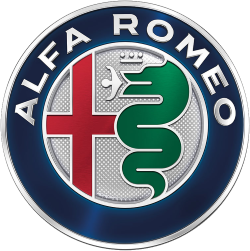 | |
| Company type | Subsidiary (S.p.A.) |
|---|---|
| Industry | Automotive |
| Founded | 24 June 1910 (as A.L.F.A.) Milan, Lombardy, Italy |
| Founders |
|
| Headquarters | , Italy[1] |
Area served | Worldwide |
Key people | Santo Ficili (CEO) |
| Products | Luxury cars[2] |
Production output | 44,115 units (2021) |
| Brands | Quadrifoglio |
| Owner | Stellantis |
| Parent | Stellantis Europe |
| Website | alfaromeo.com |
Alfa Romeo Automobiles S.p.A. (Italian: [ˈalfa roˈmɛːo]) is an Italian luxury carmaker known for its sports-oriented vehicles, strong auto racing heritage, and iconic design.[3] Headquartered in Turin, Italy, it is a subsidiary of Stellantis Europe and one of 14 brands of multinational automotive company Stellantis.
Founded on 24 June 1910 in Milan, Italy as A.L.F.A.—an acronym for Anonima Lombarda Fabbrica Automobili[a]—the company was established by Cavaliere Ugo Stella to acquire the assets of the ailing Italian subsidiary of French carmaker Darracq, of which he had been an investor and manager.[4] Its first car was the 24 HP, designed by Giuseppe Merosi, which became commercially successful and participated in the 1911 Targa Florio endurance race. In August 1915, ALFA was acquired by Neapolitan entrepreneur and engineer Nicola Romeo, who vastly expanded the company's portfolio to include heavy machinery and aircraft engines. In 1920, the company's name was changed to Alfa Romeo, with the Torpedo 20–30 HP being the first vehicle to bear the new brand.
Through the 1920s, Alfa Romeo produced several successful road and race cars, and was well represented in prominent European motorsport events, notably winning the inaugural Grand Prix in 1925. Nevertheless, the company soon faced financial troubles, leading to Romeo's contentious departure in 1928 and Italian government ownership in 1933. Under the control of the industrial organization Institute per la Ricostruzione Industriale (IRI), Alfa Romeo initially continued making its signature custom luxury vehicles, but following the financial hardship of World War II, shifted to mass-producing small vehicles. In 1954, it launched the Giulietta series of family cars and developed the Alfa Romeo Twin Cam engine, which would remain in production until 1994.
Alfa Romeo became known for producing mass-market vehicles that nonetheless blended the aesthetics and performance of sport and luxury marques. Despite its strong brand image and relatively sizeable share of the high-performance auto market in Europe, by the 1970s, the company was operating at a loss, prompting IRI to sell it to Fiat Group in 1986.[5] Alfa Romeo has since maintained its distinct identity and brand through several ownership changes, including Fiat's merger with the American Chrysler Group in 2014, forming Fiat Chrysler Automobiles (FCA), and FCA's subsequent merger in 2021 with the French PSA Group to form Stellantis.
Alfa Romeo is heavily involved in various motorsports—including Grand Prix motor racing, Formula One, sportscar racing, touring car racing, and rallies—with achievements giving a sporty image to the marque. Enzo Ferrari founded the Scuderia Ferrari racing team in 1929 as an Alfa Romeo racing team, before forming his namesake luxury sports car maker in 1939. Ferrari has had the most wins of any marque in the world.[6]
- ^ "2008 Half-yearly Financial Report/Alfa Romeo Automobiles S.p.A. Torino, Page 76" (PDF). 2008. Archived from the original (PDF) on 17 July 2011. Retrieved 18 June 2009.
- ^ "Explore Alfa Romeo Models". alfaromeousa.com. Retrieved 20 July 2022.
- ^ Gitlin, Jonathan M. (27 November 2023). "The 2024 Alfa Romeo Tonale is a confoundingly charming plug-in hybrid". Ars Technica. Retrieved 13 June 2024.
- ^ "Alfa Romeo Celebrates 90 Years of Success". autoweb.com. 2000. Archived from the original on 11 May 2009. Retrieved 9 January 2009.
- ^ Schanche, Don A. (7 November 1986). "Fiat Will Buy Alfa Romeo, Besting Ford's Bid". Los Angeles Times. Retrieved 30 June 2018.
- ^ Henry, Alan (1989). Ferrari: The Grand Prix Cars (2nd ed.). Hazleton. p. 12.
Cite error: There are <ref group=lower-alpha> tags or {{efn}} templates on this page, but the references will not show without a {{reflist|group=lower-alpha}} template or {{notelist}} template (see the help page).